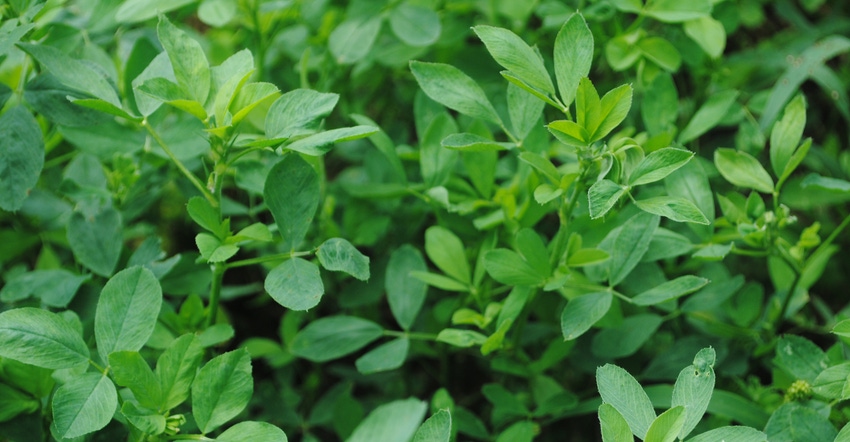
Many dryland alfalfa producers have been disappointed with yields in 2021, mostly because of drier-than-normal conditions in many parts of the Great Plains. But how do you evaluate your alfalfa stand this fall, and how do you know if it is time to renovate, start over or move on?
Ben Beckman, Nebraska Extension educator, says we normally like to evaluate an alfalfa stand in the spring, but checking stands in the fall can give you a head start in weighing your options.
Two options that Beckman suggests are evaluating the stand according to the number of plants per square foot for newer stands, or secondly, by the number of stems for established stands.
Stand counts
Determining the number of plants or stems per square foot is easy. Beckman says that a hay square, measuring 17-by-17 inches square, or a 19-inch-diameter circle work best.
“A quick and cheap option is to build one out of half-inch PVC and some 90-degree corners,” Beckman says. “If you can find a hula hoop that is 19 inches in diameter, that works too, but be prepared for some funny looks as you measure hoop diameter in the store.”
Beckman recommends choosing five random sites to sample across the field. Count the plants or stems that would be harvested. Typically, anything over 6 inches in height qualifies to determine the count, he says.
Divide those counts in half to get stems or plants per square foot. For established stands, you want 4 to 5 healthy plants per square foot, or 55 stems per square foot in a productive, healthy stand. If stem counts get below 55, there is a significant decrease in dry matter production. For new, spring-established stands, 10-15 plants or 35-55 stems per square foot should be productive.
This season has been drier in many places, so Beckman says he’d be a little more forgiving of stands that fall into the lower end of those thresholds.
“If we notice lower-than-typical counts, be prepared for lower yields next year, and keep a closer eye on it as we evaluate again next spring,” he says. “A dead plant is a dead plant, be it from insect damage, disease, winterkill or drought.”
Interseeding
On new stands, it is possible to interseed alfalfa into thin patches, Beckman says. “Alfalfa’s autotoxicity kicks in really strong after plants reach 1 year of age, but we do have a window before this to strengthen new stands,” he explains. “There is still a risk, but it’s an option each producer needs to consider for their particular situation.”
Beckman mentions another option — interseeding with a complementary grass. “We can have similar quality and yield if managed correctly,” he adds. “A total renovation is a third option. In that case, we need to consider what crop we might put on the ground next year as we give it a break between alfalfa seedings. We can do a double crop of forage species if that is needed, or decide to use a cash row crop option.”
On alfalfa stands that are deemed too thin to be productive, fall grazing may be one option to use forages that are already out there, but precautions need to be taken to ensure that there is not a problem with bloat.
“Using something like a bloat block, turning animals in for small amounts of time and gradually lengthening the time, making sure animals have supplemental feed and aren’t turned out on an empty stomach, and keeping animals off the field right after a frost or other moisture when plants are particularly high for bloat risk are practices to implement,” Beckman says. “A late harvest is also a great option, but just make sure there is enough sun and the temperature is high enough to get hay dried and cured before it is put up in a bale.”
Erosion watch
With late harvest, there is a risk for erosion, so for fields that are at high risk for erosion, the benefit of leaving a cover on the soil may outweigh the benefit of the additional forage, Beckman says.
“For very thin stands, drilling a winter cereal like rye in after a late harvest may provide some extra cover, and the opportunity for spring grazing or haying, depending on your plans for next year,” he notes. “With rye prices up this year, we need to weigh the economic cost and benefits of this, but it is another option to consider.”
Learn more about evaluating alfalfa stands by emailing Beckman at [email protected].
About the Author(s)
You May Also Like






